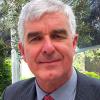
Mont-Saint-Michel is situated in a bay where the regions of Normandy and Brittany in France meet. (Pixabay/Ridoe)
On the wide expanse of France's northern coast, a vast gothic and Romanesque basilica rises above a rocky island, its dark steeple piercing the summer sky.
In the foreground, sheep graze stubbornly on salty marshes, edged by dancing poppies and windswept heather. In the distance, the shimmering tides of the English Channel run out toward the cliffs of Normandy, and beyond to England and Ireland.
When a monastic sanctuary was installed here by St. Aubert, bishop of Avranches, in A.D. 708, it quickly became a focus for pilgrims, growing in popularity when Benedictine monks arrived and a village grew up below its walls. In later centuries, Mont-Saint-Michel served as a fortress and prison, symbolizing the national faith, as well as fortitude and resilience.
Today, with a small monastic community back in residence, it is recovering its role as an outpost of prayer and contemplation in a heavily secularized society.
"It's important there are places like this which still speak of God and point toward heaven — and where the religious vocation is still visibly lived out," explained Fr. Fabien-Marie, prior of the Monastic Fraternities of Jerusalem, whose members now run the abbey. "Although the faith may have lost ground in a country like France, there are still religious people everywhere, however discreet and unassuming their presence might sometimes be."
In the Middle Ages, Mont-Saint-Michel was popularly considered an image of the heavenly Jerusalem, thanks to the splendor of its vaulted arches, galleries and stairways, which tower 250 feet above the sea on a granite platform 80 meters long.
Its Guests Hall, built beneath its refectory, was designed for royal visitors, while the Knights Hall holding up its cloister was a focus for work and study.
During the Hundred Years' War, fought between 1337 and 1453, Mont-Saint-Michel became a military stronghold, complete with ramparts and fortifications that staved off repeated English assaults. In the 18th century, it became a prison, remaining so until 1863, after which it was renovated as a historic monument and given a half-mile causeway linking it to the mainland.
Mont-Saint-Michel's religious associations changed over time too.
Dedicated to the warlike St. Michael, whose first sanctuary was built in A.D. 492 at Monte Gargano, Italy, Mont-Saint-Michel's twin status as a place of Christian devotion and martial resistance made it a major landmark.
This began to change, however, when more compassionate religious virtues came into vogue, and a growing devotion to the Virgin Mary made Marian shrines more popular. By the outbreak of the 1789 French Revolution, when the abbey's last monks were expelled by the country's new rulers, its religious functions had largely ceased.
George Gandy, an English historian who lives close to the abbey, thinks Mont-Saint-Michel's medieval architecture reflected feudal notions, with God present at the top in its abbey and monastery and ordinary life existing at its foot with the fishermen and farmers who lived by its walls. For the penitents who came here, redemption required fervent prayer, but also the physical effort of climbing countless steps, with eyes and thoughts directed upward.
"Its modern identity as a symbol of national independence gave it continued importance when most French people were no longer religious," Gandy told NCR. "But as one of the continent's oldest monasteries, it also embodies Europe's Christian roots — and that dimension seems a lot more significant for today."

The Knock Shrine in Country Mayo, Ireland, is visited by over 1.5 million people annually. (Pixabay/iroller)
With over 3 million people landing annually on Mont-Saint-Michel, the site now provides a magnet for pilgrims seeking a link with those Christian roots, as well as an opportunity for quiet contemplation away from the rush of contemporary life.
Benedictine monks returned to the abbey in 1966 and were replaced in 2001 when the Monastic Fraternities settled here from Paris. The community follows the Rule of St. Benedict and has a dozen male and female members, who combine a vigorous monastic life with caring for Mont-Saint-Michel's constant visitors.
"Welcoming tourists, and proposing they become pilgrims by witnessing with us, is our most important visible role," Fabien-Marie told NCR. "We're called, in the words of St John's Gospel, to be in the world, but not of the world. This is what our community represents: an authentic monastic life, combined with a permanent presence in the world through work and encounter."
That basic vocation is being followed by innumerable other Christian communities across Western Europe, as the church responds to new expressions of interest in religious faith against a background of secular society and culture.
In France itself, a country governed by the republican principle of laïcité, or secularity, Catholics still nominally account for over half the population of 67 million, according to surveys, although only a small proportion attends Mass.
Last January, Archbishop Michel Aupetit, the newly installed archbishop of Paris, urged church members at his installation to shun wealth and power, and look for God "in the smallest, weakest and poorest." God touched people, he added, who were "capable of recognizing and listening to him" amid the noise and complexity of modern life.
In April, France's youthful president, Emmanuel Macron, responded favorably in an address to Catholic Church leaders at the capital's College des Bernardins, in which he surprisingly called for stronger church-state ties and urged Catholics to engage in public debates more confidently.
Advertisement
"It certainly isn't the function of laïcité to deny the spiritual in the name of the temporal, or to uproot from our societies the sacred element which nourishes so many fellow citizens," Macron said. "To blind myself to the spiritual dimension which Catholics invest in moral, intellectual, family, professional and social life would condemn me to a one-sided view of France, a misunderstanding of this country, its history and its citizens."
Though attacked by politicians committed to strict secular practices in public life, Macron's speech may well, some argue, have tapped into a new openness to religious ideas in Western Europe.
In May, the Pew Research Center published a survey of attitudes about Christianity, in which it cited evidence that many citizens had drifted away from religion in the face of changing beliefs, high-profile scandals and controversial church positions on social issues.
Although church-attending Christians in France were now down to 18 percent, non-practicing Christians still heavily outnumbered the 28 percent identifying themselves as atheists, agnostics or "nothing in particular."
"Western Europe, where Protestant Christianity originated and Catholicism has been based for most of its history, has become one of the world's most secular regions," the report noted. "Yet most adults surveyed still consider themselves Christians, even if they seldom go to church."
In Britain, where 43 percent now declare themselves Christians, the self-declared "non-religious" population has grown from 31 percent to 53 percent since the early 1980s.
The terms "religious" and "non-religious" have many connotations, according to Linda Woodhead, a well-known British religious sociologist. A quarter of "non-religious" citizens say they engage in "spiritual activity," while 17 percent claim to believe in God and only one in 20 answers "definitely not" when asked if they believe in a soul and life after death.
Flourishing activities such as yoga, meditation and psychotherapy may sit uncomfortably alongside Christian beliefs and practices. But some traditional forms of church life are also showing signs of recovery — including the growing popularity of pilgrimages.
Although most of Europe's shrines keep no detailed data, many have reported a marked increase in visitors over two decades, with centers from Knock in Ireland to Mariazell in Austria now welcoming millions annually.
"To blind myself to the spiritual dimension which Catholics invest in moral, intellectual, family, professional and social life would condemn me to a one-sided view of France, a misunderstanding of this country, its history and its citizens."
-- French president Emmanuel Macron
In Portugal, the Marian sanctuary of Fatima drew 1.5 million when Pope Francis visited in May 2017 to mark the centenary of its famous apparitions. It attracted 9.4 million during the year, according to figures released in February, and three times as many foreign pilgrims as in 2016.
In neighboring Spain, 9.2 million visited Santiago de Compostela during a 2010 Holy Year, as the Way of St. James ("Camino de Santiago") pilgrimage, Europe's best known, gained popularity. In 2017, 300,000 people completed the last 70 miles of the Camino, three times as many as the previous decade. And while researchers concur that not all were motivated by Christian belief, they say many claimed some form of Christian conversion on the way.
In Britain alone, at least 30 pilgrimage routes have been created or reopened in the past decade, according to the newly created Pilgrimage Trust. England's well-known shrine at Walsingham, demolished during the Reformation, now brings in 250,000 pilgrims yearly.
"The desire to extend horizons is deeply entrenched in people — and it seems many inherently yearn for the pilgrimage experience," Raimund Joos, a German expert, told the Deutsche Welle broadcaster. "There are more and more virtual worlds, more things that are copied and aren't original anymore. What's often missing is direct contact with the world and with people — and that's what a pilgrimage offers, a way of letting go and being open to something new."
Just how far that extends to identifying with the Catholic faith is anyone's guess. For the church, it offers a chance to reach out to a fractious society, helped by committed Christians who are willing, as Francis wrote to a late May gathering of young French Catholics at Pontoise, to go to the "existential peripheries."
Besides Mont-Saint-Michel, France is rich in other pilgrimage centers, notably Lourdes in the Pyrenees, which attracts 6 million visitors yearly, and Lisieux in Normandy, burial place of the Carmelite St. Thérèse (1873-97) and her parents, Sts. Louis and Zélie Martin.
Yet French society remains secular and laïcité is still deeply rooted.
"Religion is still a private matter, and the most impressive and moving experiences are usually deeply personal ones," Gandy told NCR. "If the big Christian centers continue attracting secular people, enabling them to increase their spiritual awareness, perhaps this might over time signal some wider, collective upturn in Christian commitment. But this will clearly require much effort and dedication."
That effort and dedication is what motivates Fabien-Marie and his co-prior, Sister Claire-Anaëlle, from the Monastic Fraternities at Mont-Saint-Michel.

A stretch of El Camino de Santiago de Compostela, or the "Way of St. James," a pilgrimage route that runs over 500 miles (Pixabay/Myatsuda)
The 247-acre site has been a UNESCO World Heritage Site since 1979, and a $250 million project has been underway for the last 12 years to avoid silting and erosion by dismantling its 19th-century causeway and turning it back into an island.
Conditions are hazardous here as the tidal surge runs as high as 46 feet, making it dangerous to attempt the coastal walk across the bay. Gale-force winds regularly shake the abbey steeple with its gilded copper statue of St Michael.
Yet as a place where, according to Aubert's founding charter, heaven touches earth, it's fitting for a small community seeking to reach out to the world.
The stark, windswept setting requires physical and spiritual stamina, Claire-Anaëlle said, and provides a "good school" for the contemplative life. Impulses of conversion and "interior signals" are felt every day here among Mont-Saint-Michel's non-religious visitors, who are often surprised to find people witnessing, praying and singing the liturgy.
"It's harder to step back from real life in large, busy cities like Paris, but here you can both pray for the world and come close to the heart of God," Claire-Anaëlle told NCR. "Our task is to live out our monastic vows, while merging with the crowds converging on this place, who respond positively to the knowledge that Mont-Saint-Michel remains what it's always been — a place of prayer open to all."
[Jonathan Luxmoore covers church news from Oxford, England, and Warsaw, Poland.]






